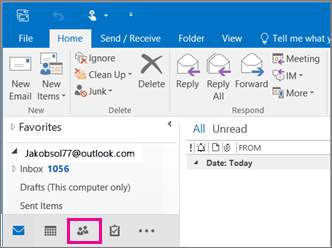If you have a lot of business or personal contact information that you keep in a spreadsheet, you can import it straight into Outlook with just a little preparation. There are three major steps.
-
Save your Excel workbook as a .csv file.
-
Import your contacts.
-
Map the Excel spreadsheet columns with the appropriate Outlook fields.
Step 1: Save your Excel workbook as a .csv file
Outlook can import comma separated value (.csv) files, but not workbooks with multiple sheets, so step 1 is saving your Excel workbook as a .csv file. Here’s how:
-
In your workbook, click the worksheet with the contact information you want to import.
-
Click File > Save As.
-
Choose where to save your file.
-
In the Save as type box, choose CSV (Comma delimited) (*.csv), and click Save.
Excel tells you “The selected file type does not contain workbooks that contain multiple sheets.” This refers to a limitation of the CSV file; nothing will happen to your original workbook (the .xlsx file).
-
Click OK.
Excel tells you “Some features in your workbook might be lost if you save it as CSV (Comma delimited).” This refers only to limitations of the CSV file and can be ignored.
-
Click Yes to have Excel save the current worksheet as a CSV file. The original workbook (the .xlsx file) closes.
-
Close the CSV file.
You're done with Excel. Now, you can start the import process in Outlook.
Note: Some locales use different list separators by default. For example, the default separator for German is the semicolon. But Outlook doesn't support the semicolon as a field separator. So you might need to replace any semicolons in the CSV file with commas before going to the next step.
Step 2: Import your contacts to Outlook
Note: If you’re importing the .csv file into an Outlook.com account (or another Exchange ActiveSync account) in Outlook, see Import contacts into an Outlook.com account.
-
At the top of your Outlook ribbon, choose File.

-
Choose Open & Export > Import/Export.
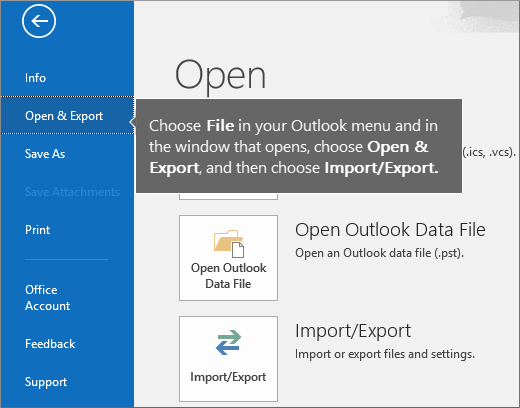
-
Choose Import from another program or file and then click Next.
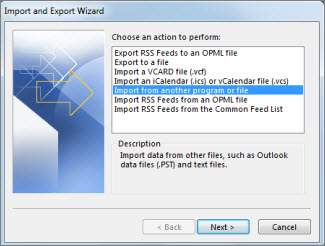
Tip: If you are prompted to enter a password and you haven't set a password, click Cancel to move to the next window.
-
Choose Comma Separated Values and click Next.
-
Browse to the .csv file you want to import.
-
Under Options, choose whether to replace duplicates (existing contacts), create duplicate contacts, or not import duplicates.
-
Click Next and choose the destination folder for your contacts. Contacts should be selected by default, but if it's not, scroll up or down until you find it. You can also choose a different folder, or create a new one.
-
Click Next.
-
Make sure the check box next to Import "MyContacts.csv" (assuming that's your file name) is selected.
-
Don't click Finish yet, because you'll need to "map" some of the columns in your CSV file to the contact fields in Outlook. Mapping can help the imported contacts turn out just the way you want.
Step 3: Map your CSV file columns to Outlook contact fields
-
Click the Map Custom Fields button. The Map Custom Fields dialog box appears.
-
Under From, you'll see a box with the column names from the CSV file you're importing.
-
Under To, you'll see the standard fields that Outlook uses for contacts. If a field matches a column in the CSV file, you'll see your column under Mapped from.
-
The fields Name, First Name, and Last Name are standard Outlook contact fields, so if the contact information in your file has any of those contact names, you're good to go.
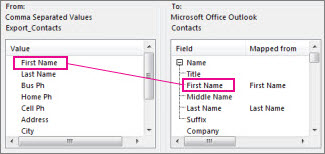
-
-
You'll probably need to do some manual mapping. For example, in this imported file, the contact's cell phone is in a column named "Cell Ph." It won't have an exact match in Outlook. But you can find a suitable match in Outlook by doing this:
-
Scroll down in the pane on the right, and you'll find Other Address, which has a plus sign (+) next to it.
-
Click the plus sign to expand what's under it, and you'll see a good match, Mobile Phone.
-
-
In the pane on the left, drag Cell Ph and drop it on Mobile Phone in the right pane.
You'll notice that Cell Ph now appears next to Mobile Phone in the Mapped from column.
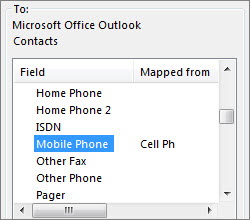
-
One at a time, drag the rest of the values from the left pane to the appropriate Outlook fields in the right pane. For example, you might drag Address to either Home Street or Business Street, depending on the type of address for your contacts.
-
Click Finish.
Your contacts are imported into Outlook.
-
To view your contacts in Outlook, at the bottom of the navigation bar, choose the People icon.
